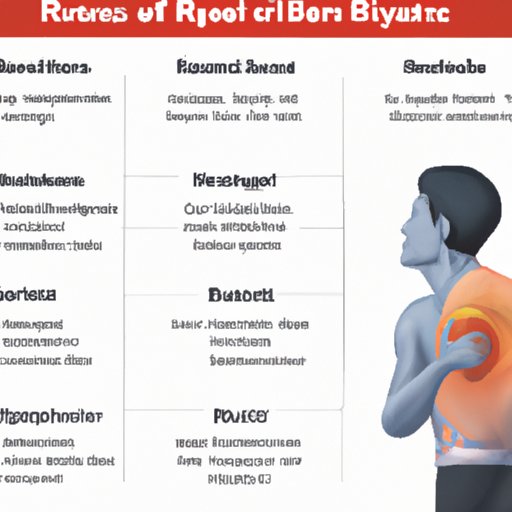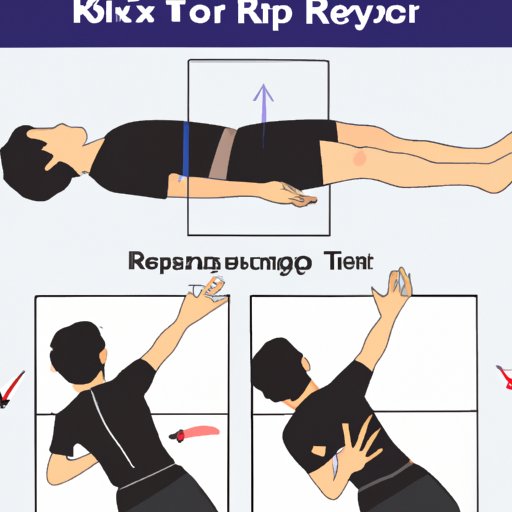Introduction
Rib pain after exercise is a relatively common issue that can range from mild discomfort to sharp, stabbing pains. It is important to understand the causes of rib pain after exercise in order to prevent and treat it properly. This article explores the causes, prevention and treatment of rib pain after working out.

Causes of Rib Pain After Exercise
There are several possible causes of rib pain after exercise. Injury to the ribs, poor posture during exercise, or overexertion during exercise can all lead to rib pain.
Injury to the Ribs
Injury to the ribs is a common cause of rib pain after exercise. Impact injuries such as falls, collisions, or contact sports can result in pain in the rib area. Strains and sprains can also occur due to overstretching or excessive force applied to the rib cage.
Poor Posture During Exercise
Poor posture during exercise can also cause rib pain. Slouching or hunching your shoulders can put extra strain on the muscles and ligaments in the rib cage, leading to pain.
Over-exertion During Exercise
Over-exertion during exercise can also contribute to rib pain. Pushing yourself too hard can cause the muscles and ligaments around the rib cage to become strained and sore.
How to Prevent Rib Pain During Workouts
In order to prevent rib pain during workouts, it is important to take certain precautions. Proper warm-up and cool down, good form with exercises, and proper breathing techniques can help reduce the risk of rib pain.
Proper Warm-up and Cool Down
A proper warm-up and cool down are essential for preventing rib pain during exercise. Warming up helps prepare the body for exercise by increasing blood flow to the muscles and loosening them up. Cooling down helps the body recover by bringing the heart rate back down and stretching out any tight muscles.
Good Form with Exercises
Using good form with exercises can also help prevent rib pain. Maintaining a neutral spine and engaging the core can help keep the rib cage in proper alignment and reduce the risk of pain.
Use Proper Breathing Techniques
Using proper breathing techniques is also important for preventing rib pain. Taking deep breaths into the abdomen instead of shallow breaths into the chest can help reduce strain on the rib cage.

Stretches and Exercises to Relieve Rib Pain
If you experience rib pain after exercising, there are certain stretches and exercises that can help relieve the pain. Foam rolling, chest stretches, and abdominal strengthening can all help reduce rib pain.
Foam Rolling
Foam rolling is an effective way to relieve rib pain. Rolling out the chest and upper back can help loosen tight muscles and reduce tension in the rib cage.
Chest Stretches
Stretches that target the chest and upper back can also help reduce rib pain. These include chest openers, shoulder rolls, and thoracic rotations.
Abdominal Strengthening
Strengthening the abdominal muscles can also help reduce rib pain. Core exercises such as planks, crunches, and bird-dogs can help strengthen the abdominal muscles and improve posture.
Common Mistakes That Lead to Rib Pain After Exercise
There are certain mistakes that can increase the risk of rib pain after exercise. Not warming up properly, relying on momentum rather than form, and focusing on speed instead of control can all lead to rib pain.
Not Warming Up Properly
Not warming up properly is one of the most common mistakes that can lead to rib pain after exercise. A proper warm-up increases blood flow to the muscles and prepares them for exercise, reducing the risk of injury and pain.
Relying on Momentum Rather Than Form
Relying on momentum rather than form when performing exercises can also lead to rib pain. Using proper form and technique helps maintain proper alignment of the rib cage and reduces the risk of pain.
Focusing on Speed Instead of Control
Focusing on speed instead of control can also lead to rib pain. Moving too quickly can put extra strain on the muscles and ligaments of the rib cage and cause pain.
Tips for Reducing Rib Pain After Working Out
There are certain steps you can take to reduce rib pain after working out. Wearing supportive clothing, listening to your body, and staying hydrated can all help reduce rib pain.
Wear Supportive Clothing
Wearing supportive clothing when exercising can help reduce rib pain. Compression garments can help provide support to the rib cage and reduce the risk of pain.
Listen to Your Body
Listening to your body is also important for reducing rib pain. Paying attention to signs of fatigue, strain, or overexertion can help prevent injury and pain.
Stay Hydrated
Staying hydrated is also important for reducing rib pain. Dehydration can cause the muscles and ligaments to become tight and strained, leading to pain.

When to Seek Medical Attention for Rib Pain After Exercise
In some cases, rib pain after exercise may require medical attention. If you experience difficulty breathing or chest pain, swelling or bruising around the rib area, or pain that persists for more than a few days, it is important to seek medical advice.
Conclusion
Rib pain after exercise is a relatively common issue that can range from mild discomfort to sharp, stabbing pains. Understanding the causes of rib pain after exercise and taking the necessary precautions can help prevent and treat it. Taking steps such as wearing supportive clothing, listening to your body, and staying hydrated can help reduce the risk of rib pain. However, if the pain persists, it is important to seek medical attention.
(Note: Is this article not meeting your expectations? Do you have knowledge or insights to share? Unlock new opportunities and expand your reach by joining our authors team. Click Registration to join us and share your expertise with our readers.)
